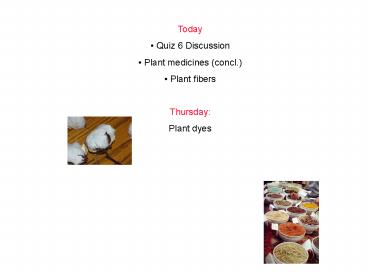PIGMENTS, PERFUMES AND POISONS - PowerPoint PPT Presentation
1 / 24
Title:
PIGMENTS, PERFUMES AND POISONS
Description:
What makes Vitamin E a 'phenolic' ... Carl Djerassi and the 'Pill' 'Steroids Made It Possible' STEROID STRUCTURE. basic structure of ... – PowerPoint PPT presentation
Number of Views:104
Avg rating:3.0/5.0
Title: PIGMENTS, PERFUMES AND POISONS
1
- Today
- Quiz 6 Discussion
- Plant medicines (concl.)
- Plant fibers
- Thursday
- Plant dyes
2
- Quiz 6 High 22 Low 3 Class Average 16.2
- 1) Glucosinolates are sulfur-containing volatile
compounds produced by plants in the mustard plant
family. - What is the meaning of volatile?
- What is typical of the molecules of volatile
compounds? - 2) Name and write one functional group that is
always found - in carbohydrates (sugars)
- b) in amino acids
- (On both quizzes)
- a) What is an alkaloid (define)?
- b) Name two examples of alkaloids
3
- (On both quizzes)
- Name two extraordinary properties of the compound
H2O - b) Where in the Periodic Chart do you find
metals? - 5) Below is the structure of Vitamin E
(tocopherol). Vitamin E is found in nuts and
seeds.
- How can you see from the molecule structure of
Vitamin E that it is water-insoluble (i.e. fat
soluble)? - What makes Vitamin E a phenolic?
- Extra Credit (2 points) Label clearly two chiral
centers in the molecule of Vitamin E above.
4
1) The leaves of cherry trees and the pits of
cherries and plums contain cyanogenic
glycosides. a) What is a glycoside? b) What does
a cyanogenic glycoside always produce when
interacting with the proper enzyme? 4) Below is
the structure of Vitamin A or retinol which our
body can synthesize from b-carotene
a) How can you see from its chemical structure
that vitamin A is colored (yellow)? b) How can
you see from its chemical structure that Vitamin
A is water-insoluble (i.e. fat-soluble)?
5
5) Vitamin C or ascorbic acid (see structure
below) is found in citrus fruit.
- What makes Vitamin C water-soluble?
- b) Vitamin C is an acid. What is an acid?
- Extra Credit (2 pts.)
- Label clearly the two chiral centers in Vitamin C.
6
Chemistry of Plant Medicines (Concl.)
- History Traditional plant medicines
- Procedures to obtain plant-derived
pharmaceuticals - Pharmacologically Active Plant Compounds
Isolated in the19th Century (Morphine, quinine,
atropine, scopolamine) - Herbal medicines
- More Recent Discoveries of Complex Plant
Compounds With Pharmacological Activity
(reserpine, vinblastine, taxol) - Drugs from Nonmedicinal Plants
- Antibiotics
- (Refer to Appendix in your Reader Old yet new
pharmaceuticals)
7
Using the Natural Molecule as a Template Drugs
from Nonmedicinal Plants
- Steroids from Yams
8
Steroids from Yams (Dioscorea spp.)
- Cortisones, contraceptives, anabolics
- Carl Djerassi and the Pill
- Steroids Made It Possible
9
STEROID STRUCTURE
- basic structure of
- 3 fused cyclohexanes and a fused cyclopentane
- (many chiral centers!)
- Steroid Functions in Humans
- membrane components cholesterol
- hormones
- sex hormones
- cortisones
D
C
A
B
10
Figure 1. Steroids from Plants
a plant saponin (as the glycoside)
_
an oral contraceptive
11
Figure 1. Steroids from Plants
12
Antibiotics
- chemical compounds derived from a microorganism
(mold or bacterium) that kill bacteria - All are organic compounds
- Chemical structures are very different from plant
compounds
13
Antibiotics from Molds
Penicillium spp. Aspergillus spp.
14
Penicillin
Penicillin G Potassium Salt
Alexander Fleming 1928
15
Practice
- Name an OTC pharmaceutical that was originally
derived from plants - What is an antibiotic?
16
Plant Fibers
Chemistry topics Polymers. Carbohydrates.
Proteins
17
Types of Fibers
- Plant Fibers
- Cotton, ramie, hemp, linen
- Animal Fibers
- Wool, silk, hair
- Artificial fibers
- Polyester, rayon, nylon ..
18
Chemistry of Fibers Polymers !
- Plant fibers
- mostly cellulose
- Animal fibers
- proteins
- Artificial fibers
- various polymers polyesters, polyamides,
19
Chemistry of Fibers Polymers !
Plant fibers are (mostly) cellulose
segment of the cellulose molecule
20
Chemistry of Fibers
Animal fibers are fibrous proteins S!
21
Experiment!Nylon-6,6, an artificial proteina
polymer!
Peptide Bond (A polyamide)
22
Artificial Polymers
Slime from polyvinyl alcohol and borax solution
23
Artificial Polymers
Slime
24
Thursday Plant dyes































